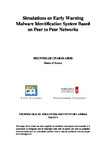| dc.contributor.advisor | Vlachos, Vasileios | en |
| dc.creator | Bountolos, Charalabos | en |
| dc.date.accessioned | 2020-07-12T09:23:48Z | |
| dc.date.available | 2020-07-12T09:23:48Z | |
| dc.date.issued | 2014 | |
| dc.identifier.other | 20943 | |
| dc.identifier.uri | http://hdl.handle.net/11615/52913 | |
| dc.identifier.uri | http://dx.doi.org/10.26253/heal.uth.8875 | |
| dc.description.abstract | The outbreak of malicious activity over the last years due to the rapid spread of the Internet and the emergence of a new generation of rapidly spreading viral software have made insufficient the use of conventional protection programs. The PROMIS algorit | en |
| dc.language.iso | en | en |
| dc.rights | Attribution-NonCommercial-NoDerivatives 4.0 International | en |
| dc.rights.uri | http://creativecommons.org/licenses/by-nc-nd/4.0/ | en |
| dc.subject | information security | en |
| dc.subject | P2P networks | en |
| dc.subject | algorithms | en |
| dc.subject | networks | en |
| dc.title | Simulations on Early Warning Malware Identification System Based on Peer to Peer Networks | en |
| dc.type | masterThesis | en |
| heal.recordProvider | Πανεπιστήμιο Θεσσαλίας - Βιβλιοθήκη και Κέντρο Πληροφόρησης | el |
| heal.academicPublisher | ΤΕΙ Θεσσαλίας. Τμήμα Μηχανικών Πληροφορικής T.E. | el |
| heal.academicPublisherID | teilar | |
| heal.fullTextAvailability | TRUE | en |
| dc.rights.accessRights | free | en |

